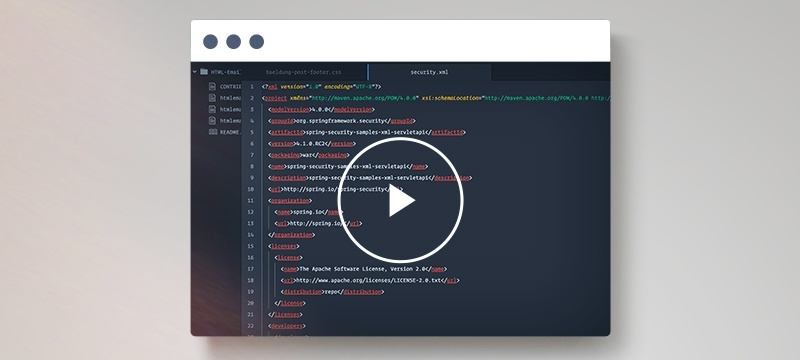1. Overview
In this tutorial, we’ll learn how to set up an Authentication Provider in Spring Security, allowing for additional flexibility compared to the standard scenario using a simple UserDetailsService.
2. The Authentication Provider
Spring Security provides a variety of options for performing authentication. These options follow a simple contract: an AuthenticationProvider processes an Authentication request, and a fully authenticated object with full credentials is returned.
The standard and most common implementation is the DaoAuthenticationProvider, which retrieves the user details from a simple, read-only user DAO, the UserDetailsService. This User Details Service only has access to the username in order to retrieve the full user entity, which is enough for most scenarios.
More custom scenarios will still need to access the full Authentication request to be able to perform the authentication process. For example, when authenticating against some external, third-party service (such as Crowd), both the username and password from the authentication request will be necessary.
For these more advanced scenarios, we’ll need to define a custom Authentication Provider:
@Component
public class CustomAuthenticationProvider implements AuthenticationProvider {
@Override
public Authentication authenticate(final Authentication authentication) throws AuthenticationException {
final String name = authentication.getName();
final String password = authentication.getCredentials().toString();
if (!"admin".equals(name) || !"system".equals(password)) {
return null;
}
return authenticateAgainstThirdPartyAndGetAuthentication(name, password);
}
@Override
public boolean supports(Class<?> authentication) {
return authentication.equals(UsernamePasswordAuthenticationToken.class);
}
}
Here, we have a generic method that returns an Authentication object. Its implementation can vary based on how we want to authenticate. As an example, we can write an example of a fixed credentials method:
private static UsernamePasswordAuthenticationToken authenticateAgainstThirdPartyAndGetAuthentication(String name, String password) {
final List<GrantedAuthority> grantedAuths = new ArrayList<>();
grantedAuths.add(new SimpleGrantedAuthority("ROLE_USER"));
final UserDetails principal = new User(name, password, grantedAuths);
return new UsernamePasswordAuthenticationToken(principal, password, grantedAuths);
}
It is worth noting that we also add an authority to our UserDetails object. In real-world scenarios, implementing the method above according to your needs is necessary as the short article may not cover all situations.
3. Register the Auth Provider
Now that we’ve defined the Authentication Provider, we need to specify it in the XML Security Configuration using the available namespace support:
<http use-expressions="true">
<intercept-url pattern="/**" access="isAuthenticated()"/>
<http-basic/>
</http>
<authentication-manager>
<authentication-provider
ref="customAuthenticationProvider" />
</authentication-manager>
4. Java Configuration
Next, we’ll take a look at the corresponding Java configuration:
@Configuration
@EnableWebSecurity
@ComponentScan("com.baeldung.security")
public class SecurityConfig {
@Autowired
private CustomAuthenticationProvider authProvider;
@Bean
public AuthenticationManager authManager(HttpSecurity http) throws Exception {
AuthenticationManagerBuilder authenticationManagerBuilder =
http.getSharedObject(AuthenticationManagerBuilder.class);
authenticationManagerBuilder.authenticationProvider(authProvider);
return authenticationManagerBuilder.build();
}
@Bean
public SecurityFilterChain filterChain(HttpSecurity http) throws Exception {
return http.authorizeHttpRequests(request -> request.anyRequest()
.authenticated())
.httpBasic(Customizer.withDefaults())
.build();
}
}
Here, we configure the authentication mandatory for all the requests and configure the Http basic authentication as well.
5. Performing Authentication
Requesting Authentication from the Client is basically the same with or without this custom authentication provider on the back end.
We’ll use a simple curl command to send an authenticated request:
curl --header "Accept:application/json" -i --user user1:user1Pass
http://localhost:8080/spring-security-custom/api/foo/1
For this example, we secured the REST API with Basic Authentication.
And we get back the expected 200 OK from the server:
HTTP/1.1 200 OK
Server: Apache-Coyote/1.1
Set-Cookie: JSESSIONID=B8F0EFA81B78DE968088EBB9AFD85A60; Path=/spring-security-custom/; HttpOnly
Content-Type: application/json;charset=UTF-8
Transfer-Encoding: chunked
Date: Sun, 02 Jun 2013 17:50:40 GMT
6. Conclusion
In this article, we explored an example of a custom authentication provider for Spring Security.
We can check out the full implementation of this article over on GitHub.





